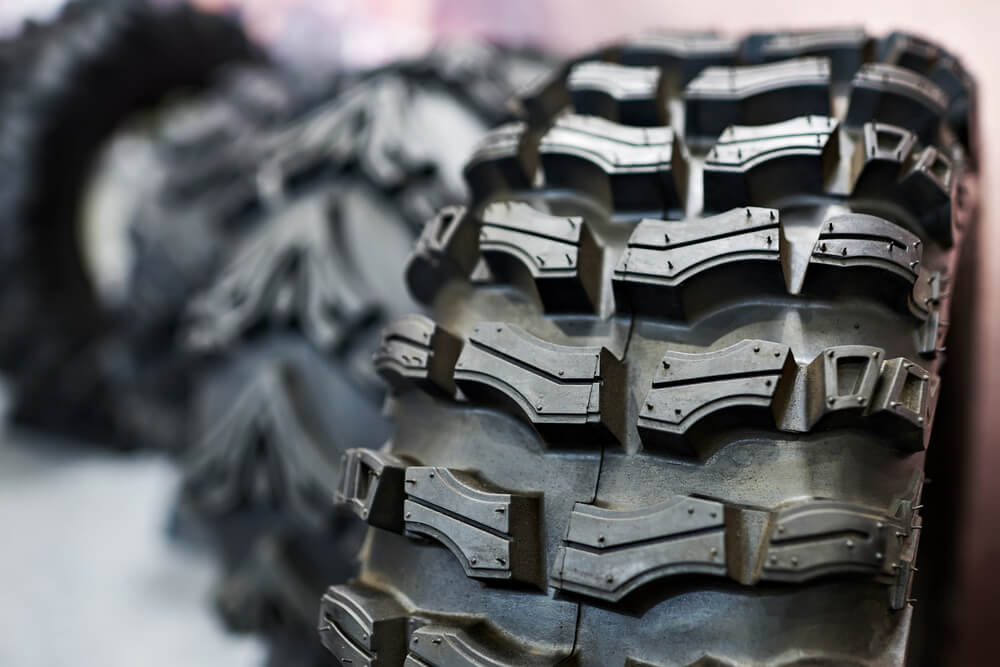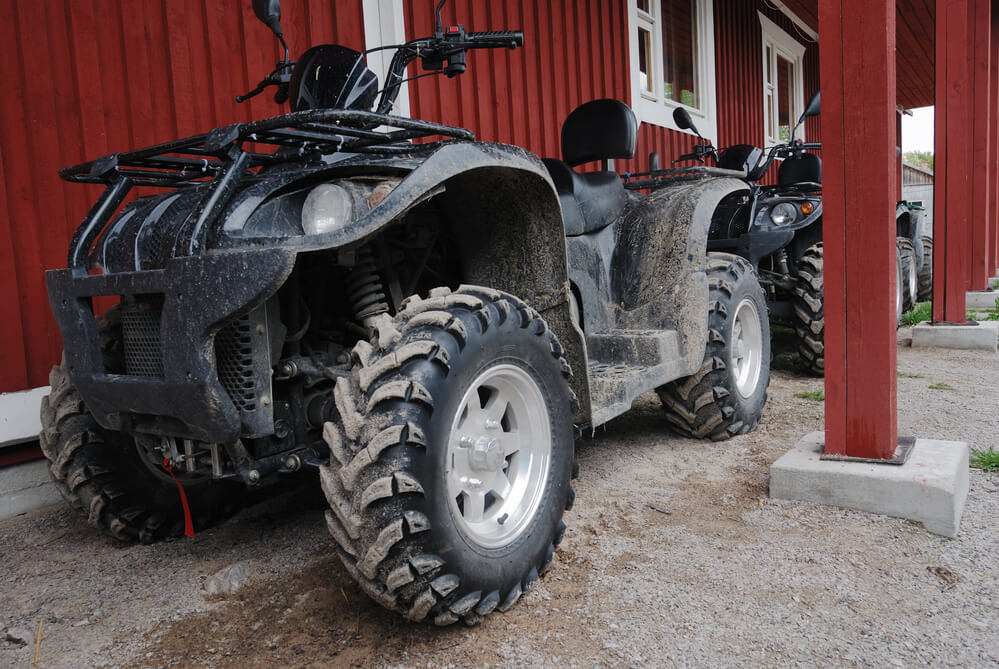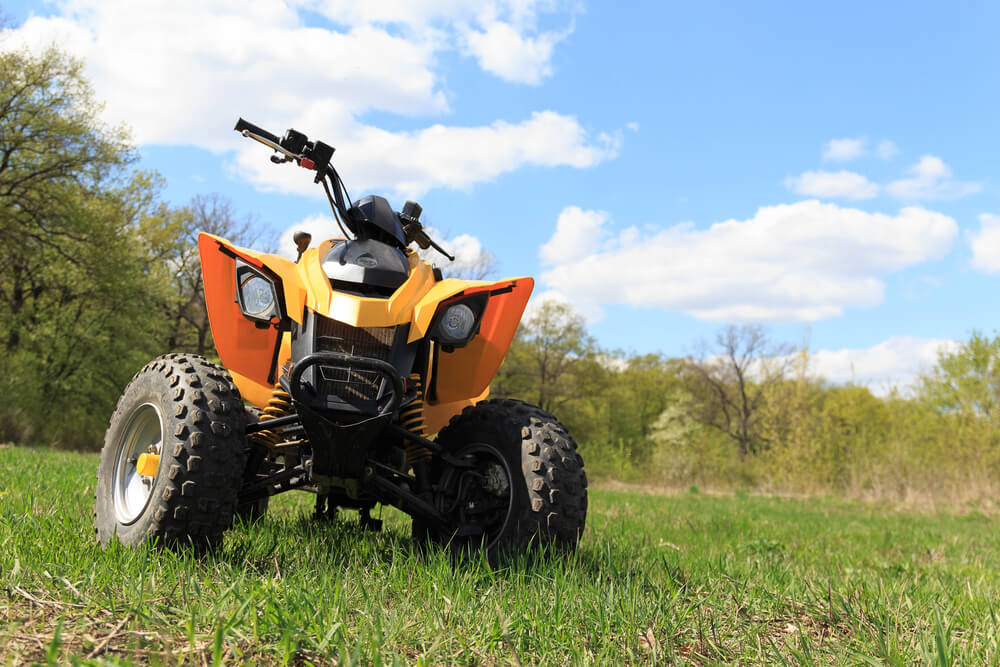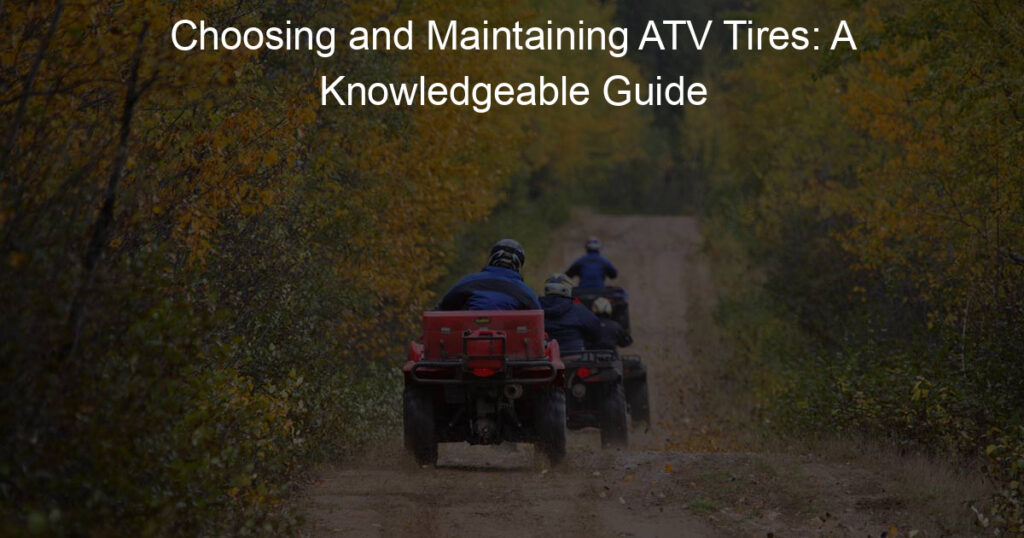All-terrain vehicles (ATVs) are versatile machines that allow you to explore various landscapes with ease, but having the right tires is essential for optimal performance and safety.
Choosing and maintaining ATV tires may seem daunting at first, but with a bit of knowledge and proper care, you can maximize your ATV’s potential and longevity.
Understanding the types of ATV tires available, considering how you’ll use your ATV, and learning proper maintenance methods will help you make the best decision when it comes to selecting and caring for your ATV tires.
ATV tires come in various sizes and tread patterns, suited for specific terrains such as sand, mud, motocross, off-road, or all-purpose use. Knowing your preferred riding environment can help you choose the right tire type, ensuring optimal performance during your excursions.
Additionally, it’s important to keep in mind that ATV tires can cost between $75 and $200 per tire on average, so you’ll want to choose a tire that fits both your budget and your usage needs.
Once you’ve selected the right tires for your ATV, understanding how to properly install and maintain them will ensure they serve you well throughout their lifespan.
Regular inspections, cleaning, and maintenance, along with tire rotation, are crucial steps in keeping your tires in top condition and maximizing their performance.
Key Takeaways
- Choosing the right ATV tires depends on your intended terrain and usage.
- Proper installation and maintenance are key to maximizing tire performance and longevity.
- Budget and riding environment should be considered when selecting ATV tires.
Choosing and Maintaining ATV Tires

Types of ATV Tires
There are various types of ATV tires designed for specific terrains and conditions. One common type is all-terrain tires, which excel in environments like soft-packed trails, water, grass, light mud, pavement, and gravel.
These tires have aggressive treads that can handle multiple types of terrain effectively.
However, you should consider specialized tires if you plan to ride mostly in specific conditions, such as mud, sand, or hard-packed surfaces. These tires have unique tread patterns and constructions tailored to their intended use.
For example, mud tires have large, prominent lugs to provide maximum traction in wet and slippery conditions, while sand tires have paddles to help propel the ATV forward in loose sand.
Tire Size and Ratings
Understanding ATV tire size is essential when selecting new tires. ATV tire sizes are typically expressed in either standard or metric format, with standard sizing being more common.
A standard-size tire might be written as 26×10-12 or, occasionally, 26x10x12 .
In this example:
- 26: Represents the overall diameter of the tire (in inches)
- 10: Represents the width of the tire (in inches)
- 12: Represents the diameter of the wheel the tire fits on (in inches)
When shopping for tires, ensure that the size corresponds to your ATV’s specifications and intended use. A larger diameter tire might provide better ground clearance, while a wider tire can increase stability and surface contact.
Also, pay attention to the tire’s load and speed ratings, which indicate the maximum weight the tire can carry and its top speed capability. These ratings can be found on the tire’s sidewall, and ensuring they match your ATV’s requirements will help maintain optimal safety and performance.
Selecting ATV Tires

Purpose and Terrain
When choosing ATV tires, it’s essential to consider your vehicle’s purpose and the terrain on which you’ll be riding. Different tire types are designed for specific surfaces and environments, ranging from all-purpose, sand, mud, and motocross to off-road ATV tires.
For example, if you frequently ride through muddy areas, selecting tires with deep treads would be ideal, as they provide better traction and prevent clogging.
Quality and Brand
The quality and brand of your ATV tires can have a significant impact on their performance and longevity. It’s important to research reputable brands and read customer reviews to find the right balance between quality and affordability.
High-quality tires often have better traction, ride more smoothly, and last longer than their cheaper counterparts.
Price and Budget
Before purchasing ATV tires, setting a budget is crucial. Tires can vary greatly in price, and understanding your financial limits will help narrow down your options.
Keep in mind, however, that cheaper tires may not always be the best investment in the long run. They may wear down more quickly or provide less reliable traction.
It may be worth spending a bit more on a quality brand to ensure your tires perform well and last longer on your preferred terrain.
Remember to consider these factors when selecting ATV tires: purpose and terrain, quality and brand, and price and budget. By doing so, you’ll be equipped with the knowledge to make the best decision for your off-roading adventures.
Installing ATV Tires

When it comes to installing ATV tires, the process can be simple if you follow the right steps.
First, gather the necessary tools, such as a lug wrench, tire irons, valve core remover, bead breaker, tire balancer, an ATV lift or jack, and an air compressor.
Before you start, park your ATV on a level surface and apply the parking brake to ensure your vehicle remains stable throughout the installation. Begin by removing the old tires using a lug wrench to loosen the lug nuts on the wheels.
Once the nuts are loose, lift your ATV using a jack or an ATV lift for better access to the tires.
After removing the old tires, inspect the rims for any cracks, bends, or damage. If the rims are in good condition, proceed to clean them by removing any dirt or debris.
Make sure the valve stems are in good shape as well; if not, replace them with new ones.
Next, use a bead breaker or tire irons to dismount the old tires from the rim. Once the tire is off the rim, check the rim’s bead-retaining bumps and the drop-well, which is essential for mounting the new tire.
Also, don’t forget to clean and inspect the tire beads for damage.
Now it’s time to mount the new tires. Position the tire on the rim, ensuring the tire bead aligns with the rim’s bead-retaining bumps3. Using a tire iron or pry bar, gently work the tire onto the rim. Kneel on one tire section and use the pry bar to seat the tire in place.
Inflate the new tire to set the bead, but be careful not to overinflate. A small, portable air compressor may not be strong enough for this job, so consider using a high-powered air compressor to ensure the beads are completely seated.
Once the bead is set, balance the tire using a tire balancer for a smoother ride.
After installing the new tires, check the tire pressure according to the manufacturer’s recommended PSI1. Regularly monitor the tire pressure, especially during extreme hot or cold conditions, as the pressure may vary.
By following these steps, you’ll be confidently riding on your new ATV tires in no time.
Maintaining ATV Tires

Regular Inspection
It’s essential to inspect your ATV tires regularly to identify any signs of damage or wear.
Look for cracks, cuts, punctures, or uneven wear on the tire’s surface. Pay attention to the tread depth, as deep treads are essential for optimal traction on muddy terrains.
Further, examine the sidewalls for bulging or exposed cords. Detecting and addressing these issues early will help extend the life of your ATV tires and ensure your safety while riding.
Proper Inflation
Proper tire inflation is crucial for the performance and longevity of your ATV tires. Regularly check the tire pressure, making sure it’s within the manufacturer’s recommended PSI range. The correct tire pressure varies based on factors such as the type of tire, load, and terrain.
For guidance on the right ATV tire pressure, refer to the tire and ATV manufacturer recommendations. Keep in mind that extreme temperatures can affect tire pressure, so you should monitor it more frequently when riding in very hot or cold weather.
Timely Rotation and Replacement
Rotating your ATV tires can help ensure even wear and prolong their lifespan. Generally, front and rear tires wear differently, so swapping them can balance the wear patterns and help maintain optimal traction.
Develop a tire rotation schedule based on your riding habits and the type of terrain you frequent.
When it comes to replacing your tires, factors such as age, mileage, and overall condition come into play. ATV tires with excessive wear, irreparable damage, or those that have reached the end of their service life should be replaced.
Timely replacement not only ensures your safety but also helps maintain optimal vehicle performance.
Regularly inspecting, properly inflating, and timely rotating or replacing your ATV tires can maximize their performance and keep your off-road adventures enjoyable and safe.
When to Replace ATV Tires

Replacing your ATV tires at the right time is essential for maintaining performance and safety. It’s crucial to be aware of the signs that indicate your tires need to be replaced.
Here are some factors to consider when determining when to replace your ATV tires.
Tire wear significantly affects your ATV’s performance and safety. Typically, tires last anywhere from 2 to 5 years, depending on usage and terrain. Inspect your tires for signs of wear, such as decreased tread depth, cracking, or bulging.
If the tread depth is less than 1/8 inch (3mm) or you notice visible signs of damage, it’s time to replace your tires.
Weather and seasonal changes can have an impact on your tires’ performance. During extremely hot or cold temperatures, the tire pressure may fluctuate, making them wear faster.
Regularly check the tire pressure according to the correct PSI and adjust as necessary to maintain optimal pressure.
Be alert for changes in your ATV’s handling and performance. If you experience decreased traction, difficulty steering, or frequent loss of air pressure, it may indicate that your tires need to be replaced.
It’s also important to choose suitable tires for the type of terrain you’ll be riding on. All-terrain tires are designed for various surfaces, while specialized tires may perform better in specific environments like sand or mud.
Riding on tires not suited for the terrain can lead to premature wear and compromise your safety.
Regularly inspecting, maintaining, and replacing your ATV tires when necessary ensures optimal vehicle performance and your safety. Keep track of your tire condition, and don’t hesitate to make a change when needed.
Conclusion
In order to get the best performance and longevity from your ATV tires, it’s important to choose the right tires for your specific needs and to maintain them properly.
By understanding the different types of tires available, such as aggressively treaded mud tires, you can make an informed decision that meets your off-roading preferences.
Tire pressure is an important factor to consider, as it can impact your ATV’s performance and safety. Be sure to check your tire pressure regularly and adjust it according to the recommended PSI levels provided by the manufacturer.
Keep in mind that extreme temperatures may affect tire pressure, so be vigilant when riding in unusually hot or cold conditions.
When it comes to ATV tire maintenance, properly inflating and inspecting your tires regularly will help ensure optimal performance and minimize potential tire-related problems.
If you need to change your ATV tires, follow the recommended steps for deflating, removing, and installing new tires.
By selecting the right ATV tires and maintaining them effectively, you can help ensure that your off-road adventures are both exciting and safe. Remember to always consult your ATV’s owner manual for specific tire recommendations and maintenance guidelines.
Frequently Asked Questions
What factors should be considered when selecting ATV tires?
When selecting ATV tires, consider the type of terrain you’ll be riding on. Different tire types are designed for various surfaces like sand, mud, motocross, or off-road use. Assess the tire size, design, and tread patterns for optimal performance and durability.
Furthermore, don’t forget to check the manufacturer’s recommendations for your specific ATV model, as they may suggest specific tire types or sizes for optimal performance.
How can you properly maintain ATV tires for longevity?
To maintain ATV tires for longevity, regularly check the tire pressure according to the correct PSI and inflate them as needed. Be aware of pressure changes when riding in extreme hot or cold conditions, as they can affect tire pressure.
Perform routine inspections for wear, damage, or punctures and address any issues immediately. Rotate your tires periodically and clean them after each ride to remove debris and prevent wear.
How often do ATV tires need to be replaced?
The frequency of tire replacement depends on factors such as usage, terrain, and tire quality. Monitor your tires for signs of wear, such as decreased tread depth or visible damage. Replace tires when they no longer provide adequate traction, have excessive wear, or if damage compromises their integrity.
As a general rule, consider replacing your ATV tires every few years or after cumulative heavy use.
What are the differences between ATV and UTV tires?
Although there are similarity in the general construction of ATV and UTV tires, they usually vary in terms of size, load capacity, and performance requirements.
UTV tires often have higher load capacities due to the increased weight of the vehicle, and they may have specific designs optimized for the type of driving experienced in a UTV.
Always choose the appropriate tire type for your vehicle based on the manufacturer’s recommendations.
How can you prevent dry rot in ATV tires?
To prevent dry rot, try to limit your ATV’s exposure to direct sunlight, as UV rays can damage tire compounds. Regularly clean your tires, removing dirt and debris that could trap moisture, and inspect them for signs of cracking or discoloration.
Store your ATV in a cool, dry place and use tire covers if your vehicle will be stationary for an extended period. Additionally, maintain proper tire pressure to minimize stress on tire walls.
Which ATV tires are least damaging to grass?
ATV tires with a less aggressive tread pattern, often called turf tires or lawn-friendly tires, are designed to minimize damage to grass. These tires have a smoother surface and rounded edges that distribute weight more evenly, reducing the likelihood of tearing up the lawn.
Nevertheless, it’s essential to note that less aggressive tread patterns may compromise traction on other terrains, so choose wisely based on your specific needs.














